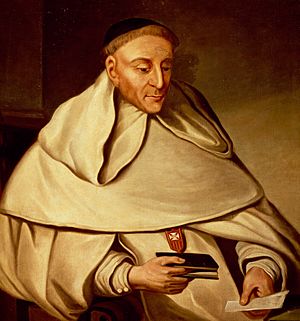Tirso de Molina facts for kids
Quick facts for kids
Tirso de Molina
|
|
|---|---|
 |
|
| Born | Gabriel Téllez c. 24 March 1579 Madrid, Spain |
| Died | c. 20 February 1648 (aged 64) Almazán, Spain |
| Signature | |
Gabriel Téllez (born around March 24, 1583, died around February 20, 1648), was a Spanish writer. He is much better known by his pen name, Tirso de Molina. He was a playwright, poet, and a Roman Catholic monk during the Baroque period in Spain.
Tirso de Molina is most famous for writing the play The Trickster of Seville and the Stone Guest. This play is where the well-known character of Don Juan first appeared. His plays are also important because they often featured many strong female characters.
Contents
Who Was Tirso de Molina?
Tirso de Molina was born in Madrid, Spain. He studied at the University of Alcalá. In 1600, he joined a religious group called the Order of the Blessed Virgin Mary of Mercy, also known as the Mercedarian Order. He became a priest by 1610.
His Time in the Americas
By 1615, Tirso de Molina had already been writing plays for ten years. His religious leaders sent him on a trip to the West Indies. He lived in Santo Domingo from 1616 to 1618. After returning to Europe in 1618, he lived in a Mercedarian monastery in Madrid. He was very active in the literary scene there, writing many plays for the stage.
Early Writings and Popularity
His first published work was Cigarrales de Toledo, which came out in 1624. This book was a mix of short stories, poems, and three plays. One of the stories, Los tres maridos burlados, and the play El vergonzoso en palacio showed how clever he was. In the introduction to this book, Tirso de Molina said he had already written 300 plays! At this time, he was almost as popular as Lope de Vega, another famous Spanish playwright. Tirso de Molina was a big fan of Lope de Vega's work.
Challenges and Changes
Tirso de Molina did not like a new style of writing called culteranismo. He made many enemies by criticizing it in his plays. In 1625, some rivals complained about him to the government, saying his plays were bad for public morals. Even though he wasn't officially punished, he was told to be more careful.
In 1626, he was moved to Salamanca. Tirso de Molina decided to stop writing plays for the stage. He didn't write new plays for about eight years after this.
Later Works and Responsibilities
Even though he stopped writing for the stage for a while, he still cared about theater. In 1626, he published twelve of his plays as the first part of his collected works. This was his way of showing he disagreed with those who had made him leave Madrid.
He also worked hard for his religious order. He became a leader at the monastery in Trujillo in 1626. In 1632, he was chosen to be the official historian for the Mercedarian Order. His book Deleitar aprovechando (1635) was a collection of religious stories and poems.
More of his plays were published in the 1630s. Some of these were written by him alone, and others were collaborations with other writers. He published five volumes of his plays between 1626 and 1636. He seemed to be in a hurry to publish them, perhaps to save his work from being lost. He even used his "nephew's" name on the title pages to avoid problems with authorities.
His active career as a playwright ended around 1636. He focused on other duties, like writing the detailed Historia de la Merced (History of the Mercedarian Order), which he finished in 1639. Tirso de Molina became the leader of the monastery in Soria in 1645, where he later passed away.

Tirso de Molina's Legacy
We have only recently learned more about Tirso de Molina's life. Only a small part of his many plays have survived. He wrote his earliest known play in 1605. By 1624, he had written 300 plays, and by 1634, he said he had written 400. However, only about 80 of these plays still exist today.
Tirso de Molina is famous for The Trickster of Seville and the Stone Guest. This play introduced the character of Don Juan to the stage. While this play shows one side of his talent, his work was much broader. For example, El Condenado por desconfiado explores deep philosophical questions. Some experts, like Fernando Cantalapiedra, believe these two famous plays might have been written by another author, Andrés de Claramonte.
Tirso de Molina was interested in many different types of characters and stories. He was a master at telling historical tales, like in Prudence in Woman. His clever and sometimes funny writing shines in plays like El vergonzoso en palacio and Don Gil of the Green Breeches. He was also very good at understanding and showing female characters, as seen in Averígüelo Vargas and La villana de Vallecas.
Tirso de Molina might not have had the endless ideas of Lope de Vega or the grand visions of Pedro Calderón de la Barca. But he was known for his strong intellect and artistic control, and he had more humor and creativity than Calderón.
His fame spread beyond Spain during his lifetime. For example, the English playwright James Shirley based his play Opportunity on Tirso's El Castigo del penséque. However, Tirso de Molina was largely forgotten in Spain for a long time after Calderón became very popular. His name was almost lost until the late 1700s.
His fame truly returned between 1839 and 1842, when a collection of his plays was published. Today, he is considered one of Spain's greatest playwrights. In 2012, his play Condenado por Desconfiado was performed in London as Damned by Despair.
See also
 In Spanish: Tirso de Molina para niños
In Spanish: Tirso de Molina para niños

